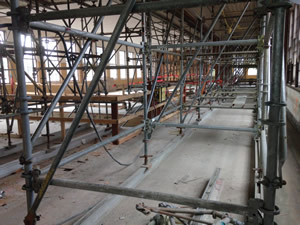Building Blueprints (Facilities in Focus)
Making Historic Schools Useful Again
- By Kenneth Fisher
- 01/01/17
As the country’s educational
facility needs continue
to grow, many cities and towns
across the United States are faced with the
option of building new schools or renovating
existing school
buildings. This choice
can have enormous
consequences in maintenance
costs, operations costs, transportation
impacts for both school users and
neighbors, as well as shaping the future
development of an area. If the renovation
option involves an historic building it only
adds to the complexity of the project, but
the benefits can be great for the entire
community.
The older a school is, the more likely
that it is located in an established neighborhood.
For the oldest schools, the city or
town has developed and densified around
them, adding new homes, neighborhoods,
businesses and infrastructure.
The intrinsic value of
the site and land for older,
established schools is
revealed through the walkability and bikeability
for students. Additionally, wellplaced
neighborhood schools contribute to
the community as a neighborhood anchor.
Planning efforts for new public schools often
involve green field sites and are driven
by educational goals with little regard
for land use and sound urban planning
principles, siting them on main thoroughfares
as opposed to being integrated with
neighborhoods.

Building Strength. During the renovation of the historic Franklin High School, in Portland, Ore.,
contractors set up temporary inside supports to stabilize the structure while they performed tasks to
improve the seismic strength of the building. This is just one of a number of issues that may need to
be researched and addressed when renovating historic schools that have aging materials and building
components that need to be replaced or refurbished in order for the school to meet the needs of
students, teachers and administrators.
Along with the celebrated historic
elements of renovating historic schools
comes the aging materials and building
components that need to be replaced or
refurbished in order for the school to meet
the needs of students, teachers and administrators.
That can include several items
that are considered dangerous, unhealthy,
irreplaceable or unusable. Add to that the
necessary close coordination with the appropriate
historic agency or agencies that
are involved with regulating historic building
renovations and the complexity reaches
a point where a program manager can add tremendous value in navigating these types
of projects to successful outcomes.
To better illustrate the common differences
that make renovating historic buildings
more challenging, here is a review of a
selection of things commonly encountered
and how to set these projects up for success.
As-built documents and drawings for
historic buildings highlight the skill of the
craftsmen who built the structures and details
years ago. In many cases, the existing
architectural plans only include about 50
percent of the detail. It is truly unbelievable
what these craftsmen did with such little
guidance on the drawings, filling in the
remaining detail with intuition and skill.
At the project outset, it is important to
fully understand the existing conditions.
If they’re not reflected on the drawings,
laser scanning or 3-D photography is
used to capture and import the building’s
details into a modern Building Information
Modeling (BIM) design platform that
architects, engineers and builders can use
to effectively estimate, design and buildout
the project. This process leads to the
development of a building model that is
about 90- to 99-percent accurate.
Some aspects of the building cannot be
captured in the scan and invariably project
teams encounter unforeseen conditions
that are hidden behind walls, under flooring
systems, in roofs or underground.
In order to investigate those areas that
have unknown material histories through
previous construction or renovations
or even through weathering and wear, a
process called “destructive testing” is recommended.
Recently, we used this method
to investigate the flooring materials on a
school that was built in 1915. Floor borings
were made in the main hallway to better
understand what is under the floor. In
some projects a material called magnesite
was used which contains the hazardous
material asbestos as a fiber additive.
Additionally, a hazardous materials survey
is important to identify any other commonly
used materials like lead paint which
was used in construction as recently as the
1970s, or even lead piping or soldering.
Because of the potential for any team to
discover unforeseen conditions, it is advisable
to have a contingency budget of at
least 10 percent and perhaps even up to 20
percent to be better suited to manage the
potential risk of costly mitigation efforts.
The experience of the team working on
these projects is critical to their success. In
the proposal request process it is necessary
to specify that historic renovation experience
is required and that the team has the
appropriate specializations. Architects, engineers
and contractors who know how to
approach these projects can artfully solve
problems and keep the projects moving
forward toward the scheduled completion
date, within budget, even while their
discovering new details that alter the plan.
While each project is somewhat unique,
experienced teams learn lessons with each
project that they apply to the next.
In some cases it is also important to have
an archaeologist on the team to identify and
process any artifacts found on the site.
Working with the appropriate local, state
and/or federal historic preservation agencies
is also important. Keeping those agencies informed
of the process allows for a smoother
schedule and contributes value to the careful
renovation of the historic school.
This article originally appeared in the issue of .
About the Author
Kenneth Fisher is a program manager at Heery International. While he has worked on several project types, he has extensive experience in managing historic renovations of schools.